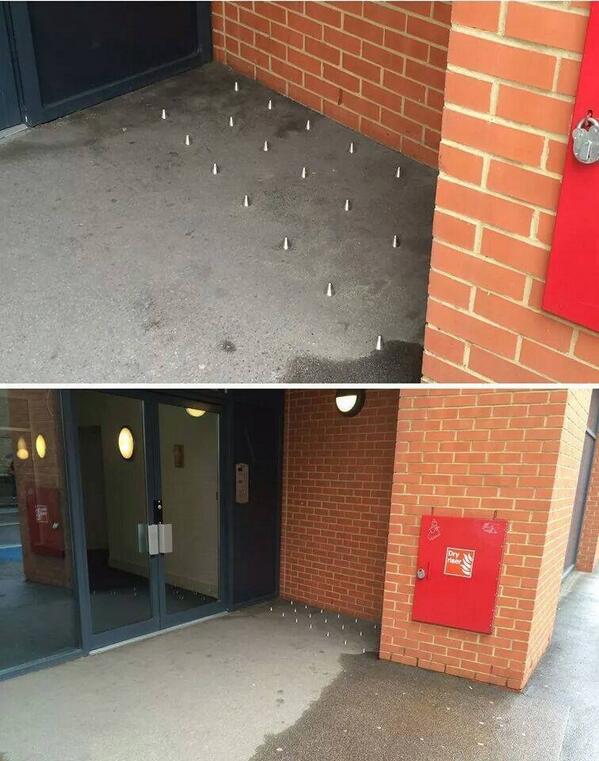Welcome to DU!
The truly grassroots left-of-center political community where regular people, not algorithms, drive the discussions and set the standards.
Join the community:
Create a free account
Support DU (and get rid of ads!):
Become a Star Member
Latest Breaking News
General Discussion
The DU Lounge
All Forums
Issue Forums
Culture Forums
Alliance Forums
Region Forums
Support Forums
Help & Search
General Discussion
Related: Editorials & Other Articles, Issue Forums, Alliance Forums, Region ForumsHow Cities Use Design to Drive Homeless People Away
http://www.theatlantic.com/business/archive/2014/06/how-cities-use-design-to-drive-homeless-people-away/373067/
Ethical Pioneer @ethicalpioneer
Follow
Anti homeless floor studs. So much for community spirit
Earlier this month, someone tweeted a picture of a series of metal spikes built into the ground outside a London apartment building.
The spikes were intended to discourage homeless people from sleeping in the area, and their presence sparked a public outcry. London’s mayor called the spikes “ugly, self defeating & stupid,” and the mayor of Montreal called similar spikes in his own city “unacceptable!!!!” Protesters poured concrete over a set of spikes outside of a Tesco supermarket. Then, after a petition was signed by nearly 130,000 people, the spikes were removed from the London apartment building, the Tesco, and downtown Montreal.
It has been encouraging to see the outrage over the London spikes. But the spikes that caused the uproar are by no means the only form of homeless-deterrent technology; they are simply the most conspicuous. Will public concern over the spikes extend to other less obvious instances of anti-homeless design? Perhaps the first step lies in recognizing the political character of the devices all around us.
An example of an everyday technology that’s used to forbid certain activities is “skateboard deterrents,” that is, those little studs added to handrails and ledges. These devices, sometimes also called “skatestoppers” or “pig ears,” prevent skateboarders from performing sliding—or “grinding”—tricks across horizontal edges. A small skateboard deterrence industry has developed, with vendors with names like “stopagrind.com” and “grindtoahault.com.” But in an echo of the protesters vandalizing the anti-homeless spikes, skateboarders find ways to combat or adapt to these measures. For example, there’s an abundance of YouTube videos in which tools are used to pop off the studs, one by one. The deterrent vendors respond with more tamper resistant alternatives. And so on.


InfoView thread info, including edit history
TrashPut this thread in your Trash Can (My DU » Trash Can)
BookmarkAdd this thread to your Bookmarks (My DU » Bookmarks)
4 replies, 2482 views
ShareGet links to this post and/or share on social media
AlertAlert this post for a rule violation
PowersThere are no powers you can use on this post
EditCannot edit other people's posts
ReplyReply to this post
EditCannot edit other people's posts
Rec (2)
ReplyReply to this post
4 replies
 = new reply since forum marked as read
Highlight:
NoneDon't highlight anything
5 newestHighlight 5 most recent replies
= new reply since forum marked as read
Highlight:
NoneDon't highlight anything
5 newestHighlight 5 most recent replies
How Cities Use Design to Drive Homeless People Away (Original Post)
xchrom
Jun 2014
OP
liberal N proud
(60,349 posts)1. So what happens when someone falls on the spikes?
In_The_Wind
(72,300 posts)2. Probably be charged with trespassing on private property.
KurtNYC
(14,549 posts)3. the "city" gathered 130,000 signatures and those spikes were removed
hunter
(38,339 posts)4. We could solve this problem with a small fraction of what we spend on war machines.
Our nation could easily provide good food, safe shelter, and appropriate medical care for all.